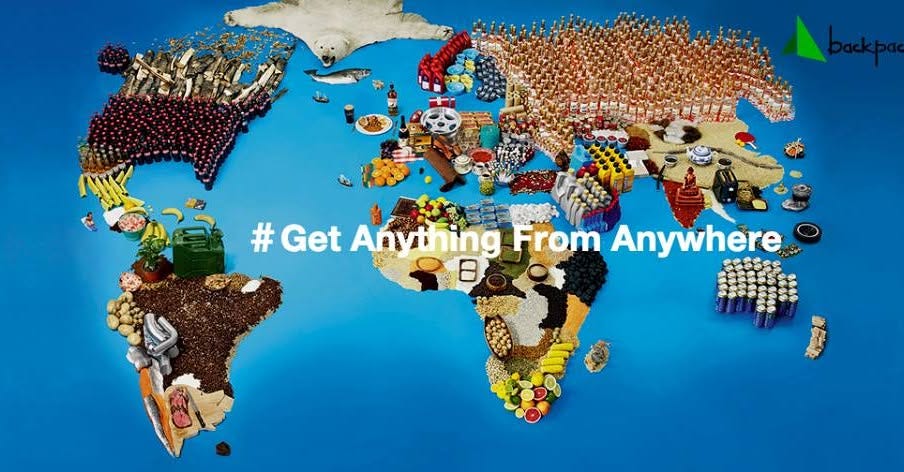BackpackBang: A Billion-Dollar Idea That Crashed and Burned
When Disruptive Ideas Fall Short: The Rise and Fall of a Company that could've changed International Retail Forever.
Imagine you're studying abroad and craving a specific brand of snacks from back home, or maybe you're a sneakerhead trying to get your hands on an exclusive release only available in Japan. You check online, but international shipping fees are outrageous, and delivery times are unpredictable. Now, what if there were an easier way—where a traveler heading your way could pick up what you need and bring it back for a small fee? That's exactly what BackpackBang aimed to do. Founded in 2014 by Bangladeshi entrepreneurs Fahim Aziz and Sakib Sauro, BackpackBang aimed to bridge the gap between consumers and international products by connecting shoppers with travelers willing to bring items across borders. This peer-to-peer platform envisioned a world where anyone could access products from overseas without the exorbitant shipping fees or the uncertainty of international delivery.
The Initial Buzz: A Startup with Global Aspirations
BackpackBang's concept was both innovative and practical. By leveraging the existing travel plans of individuals, the platform allowed shoppers to request products from abroad, which travelers would purchase and deliver for a fee. This model not only provided shoppers with access to international goods but also offered travelers an opportunity to earn extra cash. The idea garnered significant attention, leading to BackpackBang's acceptance into Y Combinator's Summer 2014 batch—a notable achievement for any startup.
Media outlets like TechCrunch highlighted the platform's potential, noting its ability to empower consumers to buy overseas products at discounted prices. The service particularly appealed to those seeking items unavailable in their home counties, from specific medications to unique electronics. In its early days, BackpackBang reported impressive traction, with the website receiving 70,000 hits from 86 countries within the first week of going live and experiencing a 15% growth per week.
For college students, this could have been a game-changer. Imagine needing a specific brand of electronics, textbooks, or even sneakers that aren't available locally—BackpackBang could have made international shopping seamless, saving students money and offering access to otherwise unavailable products. For international students, this would have been especially meaningful. Being away from home is already stressful, and sometimes, something as simple as getting a favorite snack, comfort food, or cultural item from home can make a huge difference. Instead of relying on expensive imports or waiting months for a package from family, BackpackBang could have provided a much-needed bridge between home and their new environment.
The Decline: Missed Opportunities and Stagnation
Despite its promising start, BackpackBang's momentum began to wane in the subsequent years. According to PitchBook, the company secured investments from notable entities, including Y Combinator and Inflection Ventures. However, after a funding round in 2019, the company experienced a rapid decline in performance metrics. Its growth score plummeted to 25—one of the lowest observed—and monthly web visits decreased by over 53%. Additionally, IT expenditures exceeded the total funding budget by over $126,000, indicating potential financial mismanagement.
A visit to BackpackBang's website today starkly contrasts its early ambitions. The platform appears outdated, with numerous product categories—such as electronics, beauty, and accessories—leading to blank pages or displaying fake advertisements. This lack of upkeep diminishes user trust and suggests a significant disconnect between the company's initial vision and its current execution.
What Went Wrong?
Several factors may have contributed to BackpackBang's decline:
Failure to Adapt to Market Trends: The global e-commerce landscape has evolved rapidly, with consumers seeking faster, more reliable, and tech-savvy solutions. BackpackBang's platform did not integrate emerging technologies like artificial intelligence to enhance user experience or streamline operations. For instance, implementing AI-driven algorithms could have matched travelers and shoppers more efficiently, ensuring timely deliveries and personalized recommendations.
Inadequate Marketing and User Acquisition: Relying on initial media coverage from 2014 without sustained marketing efforts likely contributed to a decline in user engagement. In today's digital age, continuous and adaptive marketing strategies are crucial to maintaining relevance and attracting new users. One of the biggest missed opportunities was failing to leverage newer media platforms like TikTok and Instagram Reels, where short-form video content drives massive engagement. Additionally, their primary market—India—has a rapidly growing e-commerce and social commerce space, meaning targeted influencer marketing or partnerships with local travel vloggers could have significantly increased visibility. Instead of capitalizing on these trends, BackpackBang remained stagnant, missing out on a highly engaged audience actively looking for alternative shopping solutions.
Platform Neglect: The website's current state indicates a lack of regular updates and maintenance. The outdated and unfinished design makes the platform look unreliable, which can immediately deter potential users. When people visit a site that looks abandoned or poorly maintained, they hesitate to spend money, fearing scams or a lack of customer support. Without trust, even the most innovative ideas struggle to gain traction.
The Bigger Picture: Lessons for Aspiring Entrepreneurs
BackpackBang's journey offers valuable insights for current and future entrepreneurs:
Innovate Continuously: An initial brilliant idea must evolve with changing market dynamics. Embracing new technologies and adapting to consumer preferences are vital for sustained growth.
Maintain Financial Discipline: Overspending, especially beyond the funding budget, can cripple a startup. Prudent financial management ensures that resources are allocated effectively to drive growth.
Engage Your Audience: Consistent and targeted marketing efforts keep the user base engaged and attract new customers. Leveraging social media, content marketing, and user testimonials can bolster a company's presence and credibility.
Prioritize User Experience: A seamless, user-friendly platform is essential. Regular updates, addressing user feedback, and ensuring functional interfaces contribute to positive user experiences and retention.
Conclusion: A Cautionary Tale
BackpackBang's story is a cautionary tale of how initial success does not guarantee long-term viability. The company's inability to adapt, innovate, and maintain its platform led to its decline, despite an idea that had the potential to revolutionize international shopping. The concept of leveraging travelers to transport goods across borders in a cost-effective and secure manner was not just clever—it was a much-needed disruption in an industry plagued by expensive international shipping fees and logistical hurdles. If properly executed, BackpackBang could have reshaped global commerce, particularly for underserved markets and consumers seeking niche or unavailable products. For budding entrepreneurs, this underscores the importance of agility, continuous improvement, and unwavering focus on delivering user value. Even the most groundbreaking ideas can falter without the right execution and a commitment to staying ahead of industry trends.
Being in the Bay Area, I always see brilliant ideas, and startups are only on the rise. But this could be us if we’re not cautious. A groundbreaking concept isn’t enough—execution and adaptation matter just as much. A platform like BackpackBang could have reshaped how we access global products, making it cheaper and more convenient, but without staying relevant, even the best ideas can fade into obscurity.
What are your thoughts on BackpackBang's trajectory? Does the concept still hold potential in today's market? Share your insights in the comments below!








